
![]() O Ecotextiles Commentary
O Ecotextiles Commentary
![]() O Ecotextiles story
O Ecotextiles story
![]() A Textile Industry Backgrounder
A Textile Industry Backgrounder
![]() Textile Global Green Standards and Certifications
Textile Global Green Standards and Certifications
O Ecotextiles Commentary
When I started delving into the wonderful story of O Ecotextiles – the company’s background and history, their global research and partnering initiatives, and their very strong commitment to challenging the textile and design communities to be much more responsive to major health and environmental concerns, I found that I was really “getting into it.” And, I realized these underlying problems can be fixed, and must not be ignored.This was a very fascinating “exercise,” and it struck a few chords with me; particularly with respect to my educational and professional background and experience, particularly in the area of toxic chemicals and pesticides.
As a chemist in the Pesticides Branch of the Foods Division of the Food and Drug Administration (FDA), my first full-time job out of college, I shook separatory funnels to extract pesticide residues from various vegetables and fruits, milk and alfalfa to see if the residues extracted met the tolerance levels set by the FDA for healthy and safe food products. And, we discovered from our research findings, that many foodstuffs still did not meet the FDA tolerance levels, which led us to be very wary and cautious with what we chose to eat. So, again, with some of the textile industry’s use of pesticides, herbicides and fungicides and other chemicals in their processing and production of fabrics, it is a wonder we wear any clothes at all!
As a testimonial to O Ecotextiles, this is a company that is really at the forefront of doing something positive about the problem in the production of their fabrics. And, it’s really about the “greening” of the textile industry. And, in doing “the right thing,” their collections are absolutely stunning! Their first fabrics coming out were sophisticated, stylish and "green," and they contend “Our fabrics are not only safe enough to eat; safe enough to use in your baby’s room and are fully compostable at end of life, but whose production is also safe for the earth and animals.”
O Ecotextiles has done much, but there is much more still to be done. Their example and continuing work should inspire and encourage the interest and support of the textile, design and end-user communitiesin helping the textile industry change the way fabrics are being made. Right now eco-textiles are harder to find, and tend to be more expensive, primarily as a result of the low volume and the slower production speeds in production without chemicals. However, the economics will change with the raising of standards across the industry that mandate textile processing and production that is non-toxic, safe, ethical and sustainable, as well as beautiful, sensuous and comfortable. In summary, the textile, design and retail communities are addressing some of the problems associated with the use of toxic chemicals in their processes, by raising awareness, education and setting an example that will raise standards across the textile industry.
Richard DeGabriel
Helen Hammond
...........................................................................................................................................................
O Ecotextiles® 
Indulgent yet Responsible, Sensuous yet Sustainable, Opulent, yet Organic,Our Green is True Blue, Safe Enough for Your Baby’s Bedroom….. Lavish Enough for Your Mother in Law.
Welcome to the ethical, exceptional world of O Ecotextiles. Seattle-based O Ecotextiles is at the cutting edge of the greening of the textile manufacturing process in their production of elegant, sumptuous organic fabrics for residential and contract/hospitality design use.
The work (and results) being accomplished by this company is a living laboratory and testimonial to it’s ambitious mission:“To change the way textiles are made by proving that it’s possible to produce luxurious, sensuous fabrics in ways that are non-toxic, ethical and sustainable.” The end result: the availability of fabrics, which are safe to bring into our homes. The company is following and implementing in real time the progress of the eco-textile community. They are proactively dealing with the severe problems associated with the use of toxic chemicals in their processes and is setting an example that will raise standards across the textile industry.
O Ecotextiles has a simple, direct and firm message: Being an organic textile means not just that a fabric uses organic fibers in the yarn, but that every step of the production process has been certified eco-friendly.“You can take organic cotton and it looks great. (But) if you spin it, weave it, dye it, print it and finish it with toxic input, it’s no longer a fabric you might want to bring into your house,” says CEO Patty Grossman. “It’s taken us six years to transfer the toxic yuck to get it out of the textile production process and still come up with a high performance, high design fabric.” “It was not easy.”
The Beginnings
O Ecotextiles was founded in 2004 by two sisters from Seattle: Patty Grossman, CEO, and Leigh Ann Van Dusen, General Manager/U.S. In search of an “indulgent, yet responsible,” and truly non-toxic and environmentally safe fabric with which to re-upholster her sofa, Van Dusen, inspired by her children to “go green,” but wanting as sumptuous fabrics as possible within that parameter, began doing research with her sister Patty Grossman. Their research found nothing that met their criteria for truly healthy, safe AND luxurious textiles. Horrified by the toxic nature of the textile process and final product,they needed to find those answers and resources that would help them make each step of their production “green,” with a healthy product for the end user. Thus, the sisters were empowered to embark on a four-year global journey to make the whole world safer while making our personal environments more beautiful. Their mission was so strongly motivated by the belief that the things we bring into our homes should not be harmful to our health or environment, that they set out to create what didn’t seem to exist: “sustainable textiles.”
The journey began with a worldwide search for partners to help them “green” each step of their production process in creating a healthy product for the end user. They wanted production partners who would produce consistently high quality fabrics in ways that are non-toxic, ethical and sustainable; partners who do not support the sale and use of the thousands of chemicals regularly applied in textile production that poison our soils, pollute groundwater, and devastate ecosystems.
And, in their search, the sisters developed a large and valuable knowledge base about toxicity in the textile arena in terms of home design. Appalled by the knowledge that textile manufacturing uses such huge amounts of energy and toxic chemicals, they wanted to shake things up in their very conservative industry.
Intelligent Choices.
Leigh Anne and Patty began looking for manufacturing partners who were green or getting greener and eager to work toward a cradle-to-cradle process of creating no-impact, perfectly safe, incredibly luxurious fabrics.
So, they searched the world to find those production partners who shared their vision and passion. With their help, the sisters were bent on cleaning up textile processing at every stage possible – and with beautiful materials, the end product!
And, in the process, theydid find some likely candidates in pockets around the world.
They began working with Romanian farmers who dew- or field-ret hemp stalks; a Japanese mill owner committed to "green" processes, even new methods such as using ozone to bleach fabric; a 100-year-old Italian mill that produces no wastewater; a Chilean mill shifting to entirely green processes; an Italian dye house that produces biodegradable, heavy-metal free textiles.
O Ecotextiles’ processing partners avoid any chemicals that are known to cause cancer, birth defects, genetic mutations or which are known endocrine disruptors. All detergents, degreasers, surfactants and soaps used are biodegradable or bioeliminable. These strict processing guidelines eliminate the harmful chemical residues in finished products that are absorbed through our skin or lungs.The company’s manufacturers treat their wastewater so it doesn’t degrade our waterways. Their fabrics are produced by people being paid fair wages, working in decent conditions. And,they insist that their production partners treat wastewater, paying careful attention to pH levels, temperature of effluent, COD and BOD levels. In addition, mill partners are asked to adhere strictly to basic production standards:
• The use of enzymatic or oxidative de-sizing only; no petroleum-based surfactants.
• The use of only biodegradable detergents, degreasers, surfactants and soaps.
• Bleaching based on oxygen only (hydrogen peroxide, ozone).
• Prohibited: halogenated solvents or any organic solvent containing benzene; chlorine containing compounds such as TCP, PCP and sodium hypochlorite; dyestuffs containing heavy metals such as antimony, arsenic, lead, chromium, copper and mercury or AZO colorants; PBDE’s or BFR; s or flame retardants of any kind; formaldehyde; dieldrin and brominated or chlorinated compounds.
Fabric Launches.
Their first fabrics coming out were, as the sisters envisioned, sophisticated, stylish and "green."“Our fabrics are not only safe enough to eat; safe enough to use in your baby’s room and are fully compostable at end of life, but whose production is also safe for the earth and animals,”as stated by Grossman, who leads the textiles group developing green standards for the Sustainability Furnishings Council.
And, though there were few in the industry that were using sustainable practices at the time, they were able to find innovative thinkers and visionaries like esteemed London designer Emily Todhunter and textile manufacturer Keshi Ikeuchi to help them get started. Emily Todhunter worked with the company to create the Emily Todhunter Organic Fabric Collection by O Ecotextiles.
The Collection.
O Ecotextiles produces 'organic fabrics' (or textiles), not just fabrics made with organic fibers. O Ecotextiles uses modern technology to turn rare and revered old-world fibers into new and appealing high-end fabrics. Their stunning website where you can almost touch and feel the fabrics echoes captions like “An old-world fiber in new world colors,” “Old world artistry for today’s demanding tasks,” “A classic workhorse with a lustrous look and a soft hand,” “Crisp and clean, almost architectural in its timeless form.” The website lists all the Eco Facts and Test Results for each textile in their Collection. The textiles are great choices for window coverage; top-of-bed; upholstery and outdoor use.http://www.oecotextiles.com/collection.php

Master Bedroom
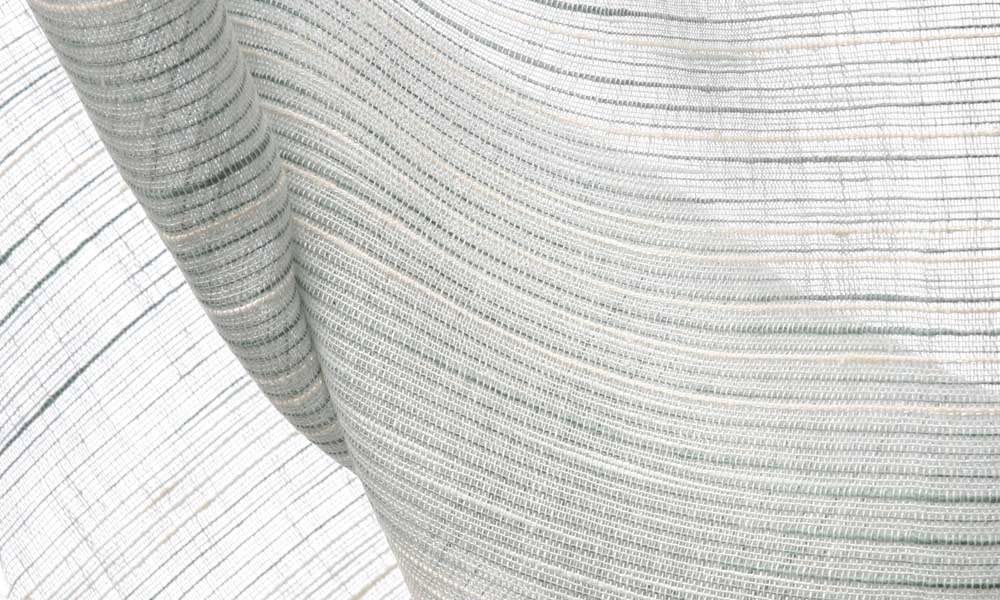
Airy Linen - Tyee

Sitting Room
The O Ecotextiles Collection is made from: bamboo, hemp, abaca, ramie, linen and silk. The company offers 14 fabric choices plus three from the Emily Todhunter Organic Fabric Collection and multiple colorways, plus custom. Talented London designer Emily Todhunter was one of the first to work with O Ecotextiles. She is using their fabrics brilliantly in her exclusive residential and commercial interiors.
And, in addition to the Emily Todhunter line, O Ecotextiles is introducing a new collection featuring responsibly processed fabrics from mills and dye houses in Eastern Europe, Italy, Japan and South America.
What Makes O Ecotextiles’ Fabrics Different?
O Ecotextiles is aggressively working toward making environmentally appealing technologies available to the mainstream, and plans to be among the forefront of companies raising peoples’ consciousness about the far-reaching implications of their textile choices. The company aims to help neutralize this chemical onslaught by greening the processing of fabrics along the entire chain choosing the most benign environmental practices and processes, and encouraging dialog about the implications of our textile choices. These strict processing guidelines eliminate the harmful chemical residues in finished products that are absorbed through our skin or lungs. With that said, O Ecotextilesfabrics are different - they are SAFE, ECO-FRIENDLY, SUSTAINABLE, and BEAUTIFUL!
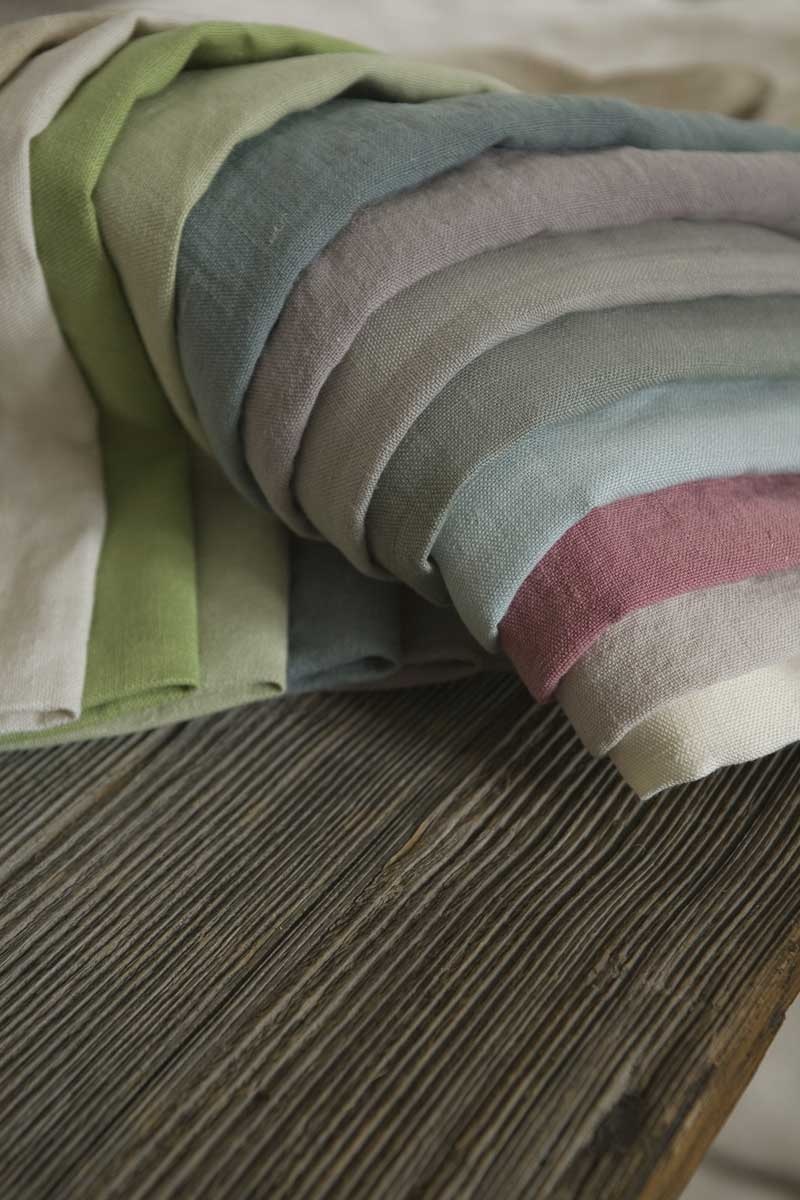
Hardy Organic Hemp - Todhunter
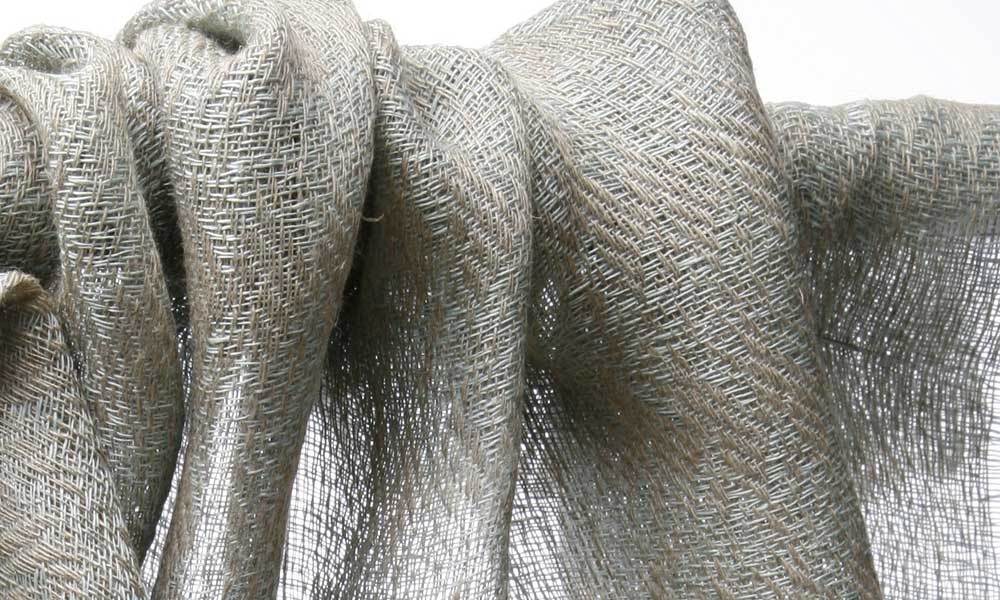
Pure Linen - Ozette Casement Fabric

QuilShoto Hemp Herringbone
Beyond Organic.
O Ecotextiles selects only high quality, natural fibers that have been grown without pesticides, herbicides or chemical fertilizers. But since growing even organically certified cotton, one of nature's thirstiest plants, can contribute to the desertification of the world, the company emphasizes the use of natural fibers such as hemp, bamboo, flax (linen), and abaca. Although agencies are not yet certifying these fibers as organic, all O Ecotextiles natural fibers are grown responsibly. For instance, all their bamboo comes from areas that do not affect panda habitat.There are organic fabrics; not just fabrics made with organic fibers. The difference is in the PROCESSING.
The company takes every opportunity to replace toxic chemicals normally used in the production process with non-toxic alternatives. During the first stage of the production process where fibers are strengthened for processing, traditionally by applying chemical glues, they use either potato starch or nothing at all. At the bleaching step, where yarn is whitened, O Ecotextiles uses ozone as the bleaching agent, rather than hypochlorites or hydrogen peroxides. At the dyeing stage, they use low-impact, fiber-reactive dyes, which react with the fabric to achieve the desired color. During the finishing, one of the final stages of the process, many textile manufacturers use silicon or belonium chloride to soften the fabric. Here O Ecotextiles treats the water used during the processing by recapturing solid waste and neutralizing the pH via enzymes and bacteria to ensure that aquatic systems are not harmed by the manufacturing process.
Global Green Standards Adherence and Adoption.
O Ecotextiles adheres to the more stringent global green standards such as the environmental and health Global Organic Textile Standard (GOTS) certification as well as Oeko Tex Standard 100, which limits certain chemicals for certified yarns. The company offers some of the very first GOTS fabrics, as well as Oeko Tex Standard 100 certified fabrics. And, their fabrics have also been tested by an Indoor Air Quality testing lab to measure chemical emissions. Test results demonstrate that the fabrics can be used to accrue LEED (the U.S. Green Building Council’s Leadership in Energy and Environmental Design) points for Indoor Air Quality. The company can also provide McDonough Braungart Design Chemistry Cradle to Cradle certified backings and polyester impregnations. In the cradle-to-grave cycle, products and byproducts enter the waste stream.
O Ecotextiles encourages and advises its consumers to look for organic textiles, but because certifications are brand new, the choices may be slim for the very near future. In the absence of a GOTS fabric as a practical choice, pay attention to the fiber used in any textile you buy. Currently conventionally raised cotton (versus organic cotton) and synthetic fibers (those made from petroleum) are the world’s most popular fibers. When choosing a natural fiber, try to avoid buying anything made with conventional cotton. This may be hard at this date, but if you have a choice, linen, hemp, bamboo, abaca, wool or any other natural fiber are good additions to the world’s textile choices, and much better eco choices than conventionally raised cotton. If you must choose a synthetic fiber, insist on recycled polyester, and, best of all, antimony free polyester. (Antimony is used in the production of most polyester, and it is an extremely toxic chemical at end of life.)
Best Practices.
O Ecotextiles routinely reevaluates its environmental best practices and life cycle assessment in light of new developments. The company encourages dialogue among consumers about the implications of their textile choices, and the website features a textile blog where shared information can help sort out the complex issues surrounding sustainable textiles.
Going Forward
O Ecotextiles is forging ahead in 2009. With their U.S. debut in 2008, the company has proven that two ideas – indulgent AND responsible – can coexist. They are organic not just because of the yarns they use (as most others claim), but also they are SAFE and HEALTHY, because of the processing they maintain to make the yarns into textiles, eliminating the 2000 or so chemicals normally used in the process. And, of course, their yarns are organic, sustainable and grown in a socially responsible way. Fabrics are made from organic sources such as bamboo, hemp, abaca, ramie and linen. And beyond that, the company says, fabrics are made in a way that is organically preferable.
O Ecotextiles has done much, but there is much more to be done. The company is confident that their example and continuing work will inspire and encourage the support of the textile industry, the design community, and the end user community to help the industry change the way textiles are being made.
News, Activities and Accolades
Cutting-edge, progressive, state of the art – new, pioneering, innovative - technology and process driven - revolutionary and evolutionary – these are only some of the key words, expressions and concepts characterizing O Ecotextiles and its founders, Patty Grossman and Leigh Anne Van Dusen. Together they formed O Ecotextiles, determined to use modern technology and processes to change the way textiles are made by turning rare and revered old-world fibers into new and appealing high-end fabrics that are luxurious and sensuous, and non-toxic, ethical and sustainable.
September 2007.
O Ecotextiles’ line with top British designer Emily Todhunter won a House & Garden magazine award at Decorex 2007 in the U.K.
July/August 2008.
At the Hampton Designers Showhouse in Sagapanack, NY, O Ecotextiles textiles graced the master bedroom: draperies, top-of-bed, and the furniture upholstery.
August 2008.
World Renowned Color Expert, Leatrice Eiseman (Lee), who has been called "America’s color guru,” joinedO Ecotextiles Advisory Board. Lee helps companies make the best and most educated choice of color for product development, logos and identification, brand imaging, web sites, packaging, point of purchase, interior/exterior design or any other application where color choice is critical to the success of the product or environment.
September 2008.
OEcotextiles made its debut at the “West Coast Green’s prestigious conference and expoat the San Jose Convention Center in San Jose, California. Here the company showcased their award-winning Uber-Green, healthy and safe textiles for interior design. (One stunning new print was selected by Zem Joaquin/EcoFabulous to grace the master bedroom of the expo’s Showhouse.)
November 2008. O Ecotextiles was announced on November 20, 2008 during Greenbuild International Expo as one of BuildingGreen’s 2008 Top-10 Green Building Products by the editors of Environmental Building News and GreenSpec.” This seventh annual award recognizes the most innovative and exciting green building products added to the GreenSpec Directory during the past year or covered in Environmental Building News.
January 2009.
O Ecotextiles launched its New York distribution when their fabrics were selected to be carried in the Michael Tavano showroom in the New York Design Center.
Recent Achievements:
Patty Grossman heads the Textiles Division for the Sustainable Furnishings Council.
Patty Grossman and Leigh Anne Van Dusen have appeared in World of Interiors, Interior Design, House & Garden UK, Domino, Traditional Home, The Sunday Telegraph, InteriorDesign.net, Contract, WorldChanging.com, and numerous trade magazines and blogs.
O Ecotextiles, Inc.(www.oecotextiles.com) Corporate headquarters are in Seattle at 942 18th Avenue East,Seattle, Washington 98112. The company has representatives, retail stores and showrooms throughout the United States, London Ontario, Canada, the United Kingdom, and Europe (France, Norway, Portugal and Sweden). Their collection is currently available in select design centers and retailers throughout the U.S., as well as London and through the corporate office in Seattle. They hope their example will inspire others to follow suit.
http://www.oecotextiles.com/where_to_find.php. Lists locations, Representatives, Retail Stores, Showrooms, etc.
...........................................................................................................................................................
A Textile Industry Backgrounder
Health and Environmental Hazards; Awareness and Choices
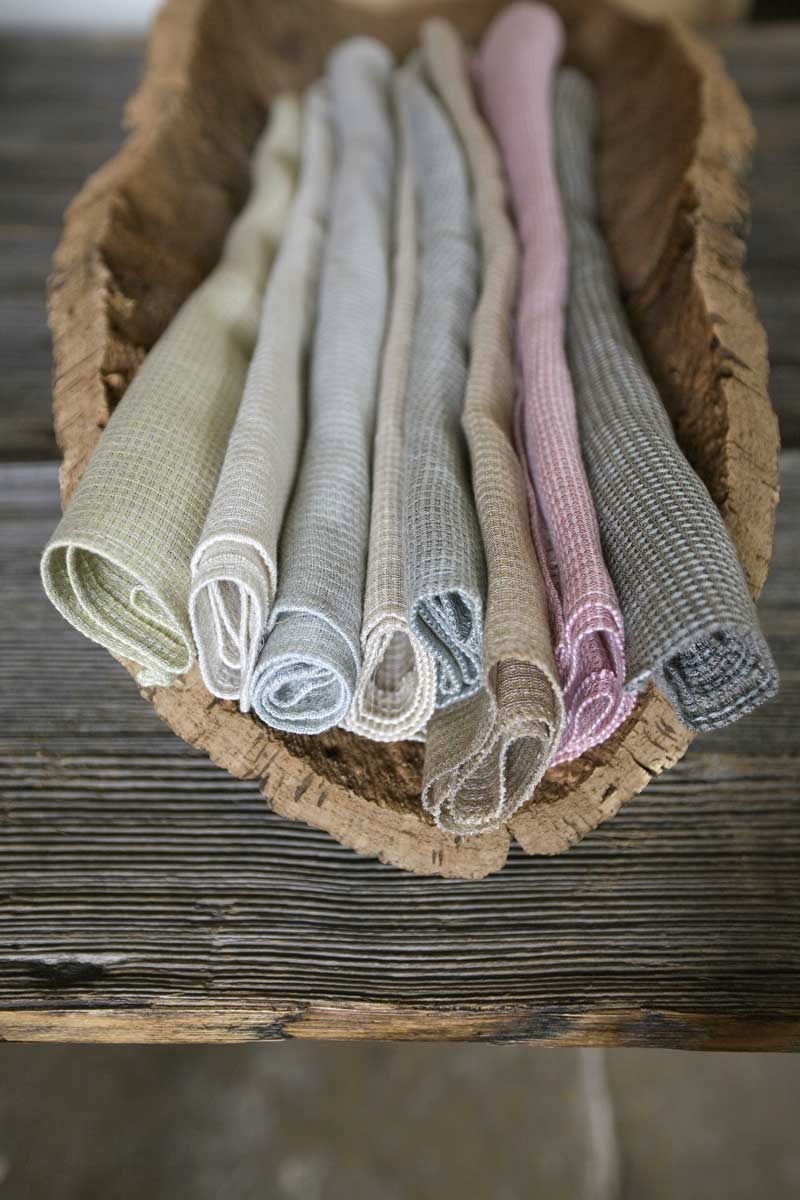 Health and Environmental Hazards.
Health and Environmental Hazards.
There are hidden dangers in processing textiles, one of the most chemically intensive activities on earth, and perhaps the worst industrial polluter of clean water. Residues left in the finished products are now being investigated for dangers to personal health. Traditionally produced fabrics contain residuals of chemicals that evaporate into the air we breathe or are absorbed through our skin. Some of these chemicals may trigger allergic reactions, asthma - and much worse. Many textile manufacturers use dyes that release aromatic amines (e.g., benzidine, toluidine). Dyebath effluents may contain heavy metals, ammonia, alkali salts, toxic solids and large amounts of pigments. And, there is much more to be done than simply using organically grown fibers.Seattle-based O Ecotextiles (www.oecotextiles.com)has done a significant amount of research into the “state of the industry” with respect to toxicity, health and environmental hazards in the processing of textiles and wants to help change the way textiles are made by proving that it's possible to produce luxurious, sensuous fabrics in ways that are non-toxic, ethical and sustainable. Here are some of their findings:
The textile industry has been condemned as being one of the world’s worst offenders in terms of pollution, because it requires two components: Chemicals and Water.
Chemicals
As many as 2,000 different chemicals are used in the textile industry, from dyes to transfer agents. The chemically infused effluent-saturated with dyes, de-foamers, detergents, bleach, optical brighteners, equalizers and many other chemicals, is often released into the local river, where it enters the groundwater, drinking water, the habitat of flora and fauna, and our food chain. Many of these chemicals are known to cause profound health problems in humans.
Water
Water is used at every stage in fabric manufacturing: to dissolve chemicals to be used in one step, then to wash and rinse out those same chemicals to be ready for the next step. Water is used both to convey the chemicals used during a step and to wash them out before beginning the next step. The water becomes full of chemical additives and is then expelled as wastewater, which in turn pollutes the environment by the effluent’s heat, its increased pH, and because it’s saturated with dyes, de-foamers, bleaches, detergents, optical brighteners, equalizers and many other chemicals used during the process.The textile industry is considered the No.1 polluter of clean water (after agriculture).
Traditionally produced fabrics contain residuals of chemicals used during their manufacture – chemicals that evaporate into the air we breathe, or are absorbed through our skin. Some of the chemicals are carcinogenic or may cause harm to children even before birth, while others may trigger allergic reactions in some people. There are many steps in the production of fabric AFTER the raising or extraction of the raw fiber material. Textile production steps can include carding, retting, scouring, bleaching, spinning, weaving, dyeing, printing and finishing. These steps use a lot of chemicals and water.
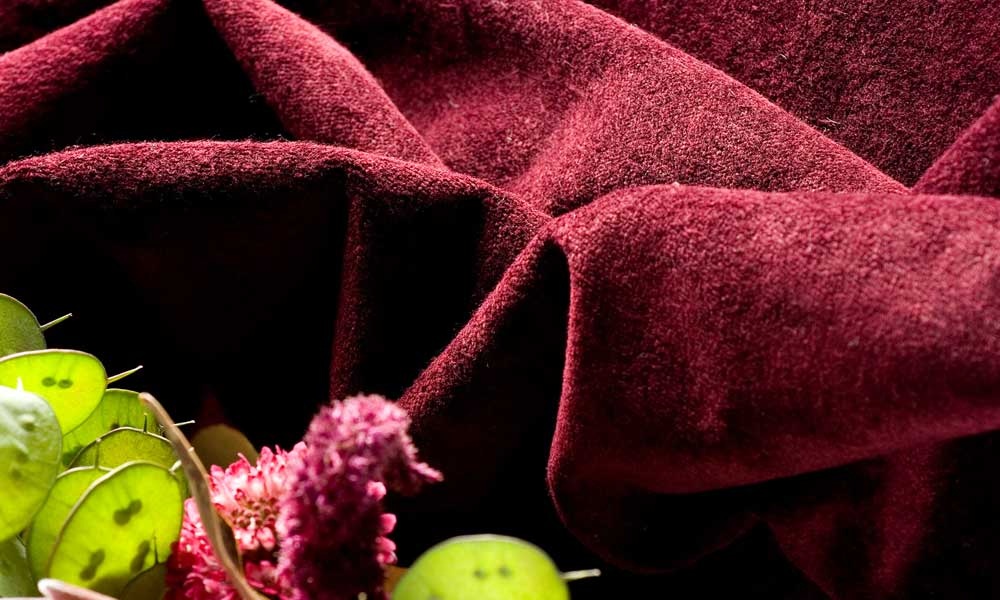
Belgian Bamboo-Northern Lights
Fibers.
Currently cotton is the world’s most popular natural fiber – accounting for 80% of all natural fibers used in the world. Cotton is also the world’s worst environmental and health choice. It is the second most damaging agricultural crop in the world. Conventional cotton must be drenched with chemicals and it accounts for 25% of all pesticides used globally. The cultivation of cotton requires inordinate amounts of herbicides, pesticides and fungicides. Most cotton is irrigated, and the combination of chemical applications with irrigation is a direct conduit for toxic chemicals to circulate in groundwater worldwide. They can pollute the groundwater and enter the food chain. Conventionally grown cotton is so full of pesticides that in California, farmers can no longer legally use the leftover leaves and stems to feed their livestock. Cotton also demands vast quantities of water, resulting in soil salinization, aquifer depletion and desertification of large tracts of entire countries.
Sizing.
In sizing, no polyvinyl alcohol (PVA) should be used; O Ecotextiles requires its mills to use potato starch or carboxymethylcellulose (CMC), which is allowed under Global Organic Textile Standard 2.3.5.
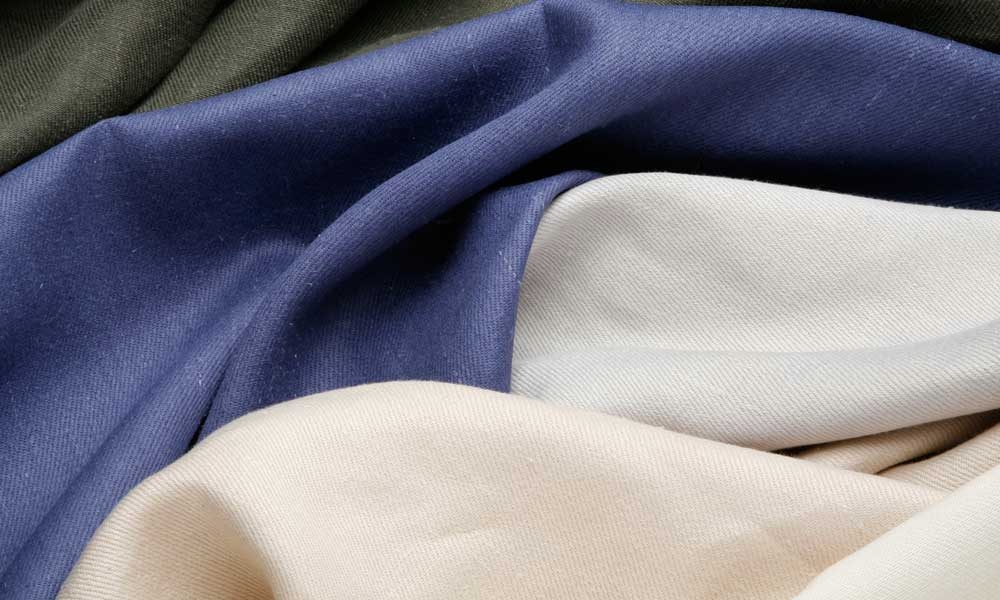
Pure Hemp Twill-Rogue River
Bleaching.
Many textile manufacturers use dyes that release aromatic amines (e.g., bezidine, toluidine). Dyebath effluents may contain heavy metals, ammonia, alkali salts, toxic solids and large amounts of pigments. About 40% of globally used colorants contain organically bound chlorine, a known carcinogen. Natural dyes are rarely low-impact, depending on the specific dye and mordant used. Mordants such as chromium are very toxic and high impact. The large quantities of natural dyestuffs required for dyeing, typically equal to or double that of the fiber’s own weight, make natural dyes prepared from wild plants and lichens very high impact.
- Low-impact reactive dyes in a closed-loop system should be used. They are the lowest-impact fiber reactive dyes available, but are by no means low impact. At best, about 80% of the dyestuffs stay on the fabric, while the rest go down the drain (although the water is contained and treated before returning to the ecosytem.)
- Dyes containing no heavy metals should be used, so the dye house wastewater treatment yields pristine water.
Finishing.
Functional finishes (such as flame-retardants) should not be applied to fabrics. O Ecotextiles offers the application – after manufacture – of certain flame-retardants having no VOCs, PBDEs, deca-BFRs, or other hazardous chemicals. And, rather than using harsh chemicals to soften and finish fabrics, O Ecotextiles’ finish is made of bees wax, aloe vera and Vitamin A.
Awareness and Choices.
Industry and consumer awareness needs to be heightened about textile choices to support environmentally preferable processes, practices, power sources and materials, from the start of the textile process to the arrival in our homes. O Ecotextiles is proving and demonstrating that it is possible to change the way fabrics are made; that it is possible to produce luxurious, sensuous fabrics in ways that are non-toxic, ethical and sustainable. And the company is “putting their money where there mouth is “ and offering intelligent choices – safe, healthy, sustainable, eco-friendly and authentic textile choices - to the industry and to their consumers.
O Ecotextiles’ mills have wastewater treatment in place to prevent liters of chemically infused effluent from entering the environment.
Chlorine bleach is known to be harmful to the environment and to consumers; yet chlorine-based chemicals are still often used to bleach fabrics. In O Ecotextiles' mills, the bleaching method of choice is oxygen-based (hydrogen peroxide) and the wastewater is treated. In one mill, ozone, a very new technology, is used for bleaching. 

Rather than using harsh chemicals to soften and finish their fabrics, O Ecotextiles' finish is made of bee's wax, aloe vera and Vitamin E.
And, O Ecotextiles is testing some new flame retardant finishes that claim to be free of VOC's, PBDE's, deca-BFR's or brominated based chemicals. The companies that produce these flame-retardants claim that they can meet most fire codes and the results of these tests will be posted when they become available. 

Although the cultivation of organic cotton largely solves the problems associated with the use of chemicals, organic is still classified as one of the top “thirsty” crops by Oxfam, leading to the same problems of soil salinization, aquifier depletion and desertification. Organic cotton is a better choice than goods made from conventionallyraised cotton. Linen, bamboo, hemp and abaca are good additions to the world’s fiber choices. Demand organic textiles, even though ecotextiles are hard to find, and right now they are more expensive, primarily because of low volume and the slower production speeds in production without chemicals.
...........................................................................................................................................................
Textile Global Green Standards and Certifications
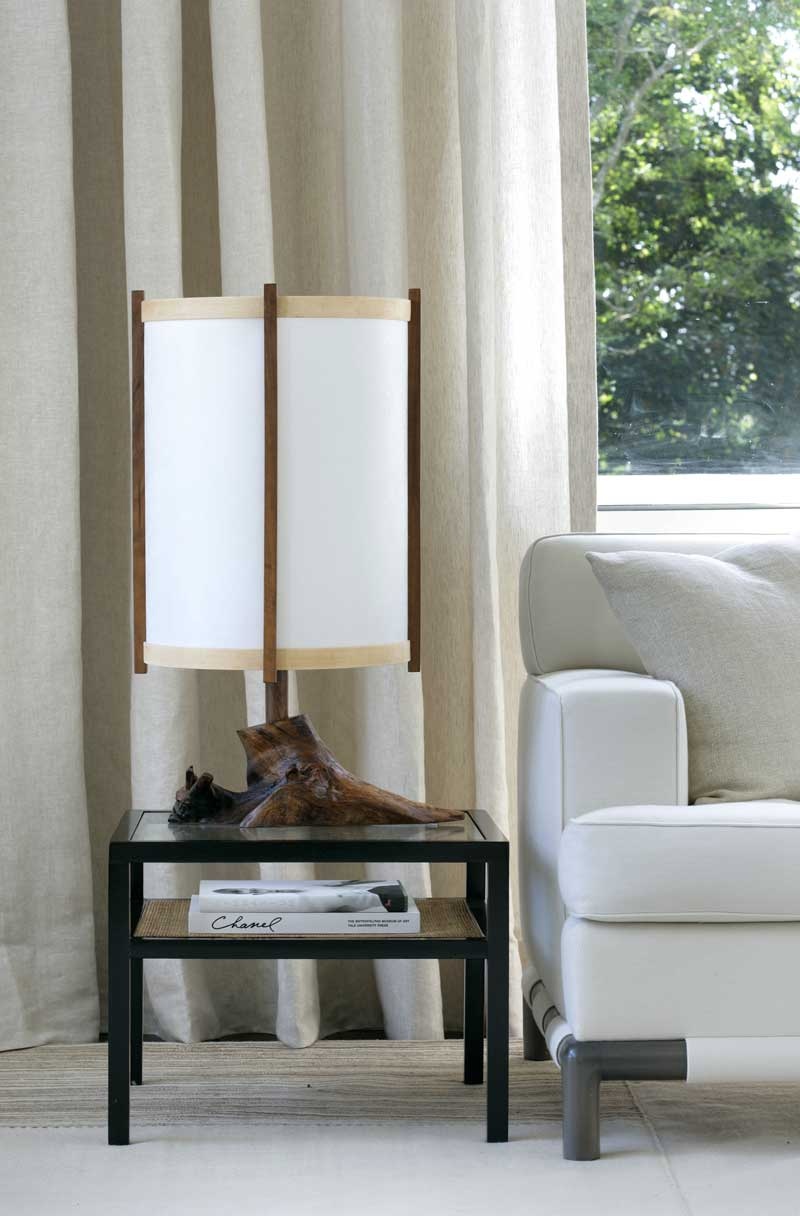 In the industry, there are currently many different competing textile certifications, and the scene is somewhat confusing. Any of them – GOTS, Blue Sign, Cradle to Cradle, Green Guard, the EU Eco-Label or Flower, Oeko-Tex – are a good choice right now, because there are so few fabrics that are certified. Both GOTS and Blue Sign include fair trade and workers’ rights considerations.
In the industry, there are currently many different competing textile certifications, and the scene is somewhat confusing. Any of them – GOTS, Blue Sign, Cradle to Cradle, Green Guard, the EU Eco-Label or Flower, Oeko-Tex – are a good choice right now, because there are so few fabrics that are certified. Both GOTS and Blue Sign include fair trade and workers’ rights considerations.
The more stringent global green standards are the environmental and health Global Organic Textile Standard (GOTS) certification as well as Oeko Tex Standard 100, which limits certain chemicals for certified yarns. Companies like Seattle=based O Ecotextiles (www.oecotextiles.com)offer some of the very first GOTS fabrics, as well as Oeko Tex Standard 100 certified fabrics. A company’s fabrics can be tested by an Indoor Air Quality testing lab to measure chemical emissions and positive test results allow fabrics to accrue LEED (the U.S. Green Building Council’s Leadership in Energy and Environmental Design) points for Indoor Air Quality. There are also McDonough Braungart Design Chemistry Cradle to Cradle certified backings and polyester impregnations that companies can provide. In the cradle-to-grave cycle, products and byproducts enter the waste stream. According to the U.S. Environmental Protection Agency, the air quality in an average home is 10 times more polluted than outdoor air.
The Sustainable Textile Standard (STS).
GreenBlue, founded in 2002, is a nonprofit institute that simulates the creative redesign of industry by focusing the expertise of professional communities to create practical solutions, resources, and opportunities for implementing sustainability.The institute was originally a nexus of projects at McDonough Braungart Design Company (MBDC), the private sustainable product and process design consultancy co-founded by American architect William McDonough and German chemist Michael Braungart in 1995. GreenBlue is currently working with academic, non-profit, and industry partners to develop a shared, comprehensive, cradle-to-cradle Sustainable Textile Standard (STS) for application in all aspects of the textile industry.
The STS offers an ambitious paradigm for textiles of the future and proposes five distinct metrics that form a composite view of sustainability. Levels of achievement within each category involve in-depth analysis of processes that are distinct to the textile industry and benchmarking of industry average performance, ensuring that all metrics are specific and directly relevant to the current practices of the textile industry. To attain the highest level of achievement described by the STS, truly sustainable textiles would meet or exceed all industry performance and cost requirements, delight the end user through pleasing aesthetic and tactile qualities, and would meet the following five enhanced quality metrics:
- Safety of chemical and material inputs. All materials and process inputs are safe for human and ecological health in all phases of the product life cycle.
- Energy efficiency and mix. All energy, material, and process inputs come from renewable sources.
- Water efficiency and effluent quality. All materials are capable of returning safely to either natural (biological nutrient) or industrial (technical nutrient) systems.
- Recycling and actual reclamation. All stages in the product lifecycle actively support the reuse of recycling of these materials at the highest possible level of quality.
- Social equity for workers.All persons involved with the creation of textiles are treated fairly with respect to human rights and given training to increase their mastery of this craft.

Hemp - Tacoma Traditional Herringbone
Because certifications are brand new, when looking for organic textiles, the choices may be slim for the very near future. In the absence of a GOTS fabric as a practical choice, pay attention to the fiber used in any textile you buy. Currently conventionally raised cotton (versus organic cotton) and synthetic fibers (those made from petroleum) are the world’s most popular fibers. When choosing a natural fiber, try to avoid buying anything made with conventional cotton. This may be hard at this date, but if you have a choice, linen, hemp, bamboo, abaca, wool or any other natural fiber are good additions to the world’s textile choices, and much better eco choices than conventionally raised cotton. If you must choose a synthetic fiber, insist on recycled polyester, and, best of all, antimony free polyester. (Antimony is used in the production of most polyester, and it is an extremely toxic chemical at end of life.)
© DesignIntituit, 2000-2011
Use of any content from this site or publications is strictly prohibited without the written consent of DesignIntuit, 2011
ABOUT US | CONTACT | SITE MAP | PRIVACY POLICY
Web Design by: Caught in the Web

